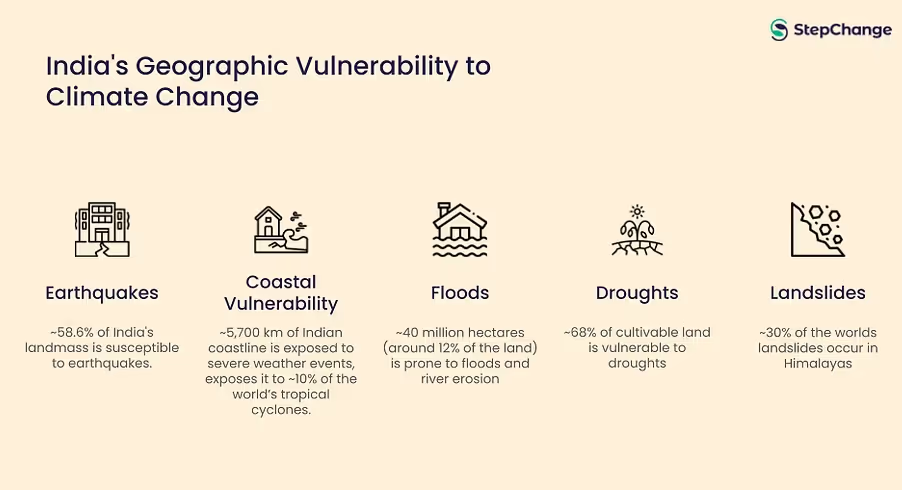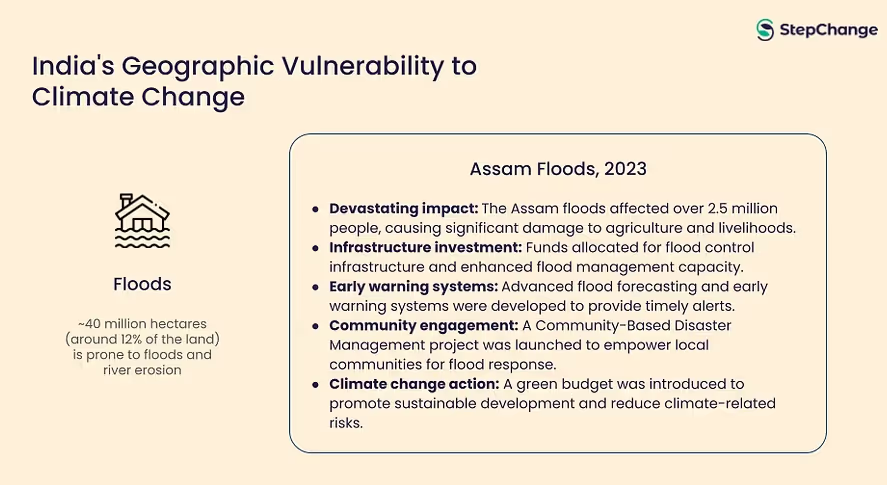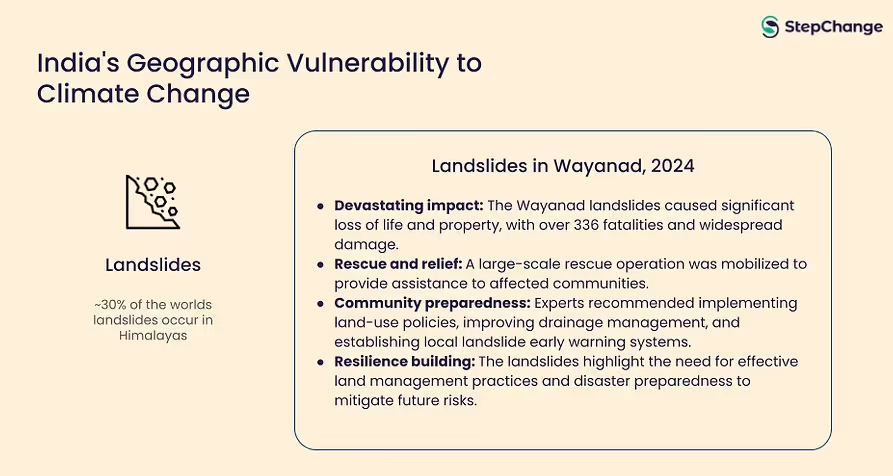
Solutions
Carbon Management
ESG Intelligence
Climate & Nature Risk
Data Registry
Beta
Sector
Get started, schedule a demo or request a free assessment!


World Environmental Health Day 2024 focuses on the theme "Environmental Health: Creating Resilient Communities through Disaster Risk Reduction and Climate Change Mitigation and Adaptation." This theme underscores the critical need to enhance community resilience in the face of climate-related disasters, which have become increasingly frequent and severe due to global warming. By emphasizing disaster risk reduction (DRR) and climate change adaptation, this year's theme calls for integrated approaches that not only protect public health but also ensure sustainable development.
India's unique geography and climate make it one of the most disaster-prone countries in the world. With 27 out of 29 states and 7 union territories susceptible to natural hazards like floods, cyclones, droughts, and earthquakes, the country faces an uphill battle against the devastating impacts of climate change. As World Environmental Health Day 2024 approaches, it's crucial for India to take bold steps to enhance community resilience and protect its vulnerable populations.
India's geographical factors significantly contribute to its disaster risk profile, making it one of the most disaster-prone countries in the world. The combination of its diverse topography, climatic conditions, and demographic factors creates a complex landscape of vulnerabilities:

India is situated at the convergence of several tectonic plates, making it prime for earthquakes. ~58% of the country’s landmass is classified as being at risk for earthquakes of moderate to very high intensity. This seismic vulnerability is particularly pronounced in regions such as the Himalayan belt, which experiences tremors due to ongoing tectonic activity.
For instance, the 2001 Bhuj earthquake, which registered a magnitude of 7.7, resulted in over 20,000 deaths and injured more than 150,000 others. The earthquake affected approximately 28 million people, destroyed more than 400,000 buildings, with the telecom building collapsing, Bhuj was isolated from the rest of the state; the most seriously affected was the Kandla port (the busiest port in India) which caters to handling crucial imports of petroleum products, crude oil and chemicals and export of agricultural commodities, with about five of the 10 jetties damaged. Over 10,000 small and medium industrial units had to stop production due to damage to plants, factories, and machinery. The Indian State Department estimates that the earthquake affected, directly or indirectly, 15.9 million people out of 37.8 million. The government estimated the direct economic loss at $1.3 billion, while estimates indicate this could be as high as $5 billion.
Following the earthquake, emergency relief operations were launched by both government and non-governmental organizations (NGOs):

The resilience-building activities undertaken after the Gujarat earthquake reflect a comprehensive approach that combines immediate relief with long-term strategies aimed at enhancing community preparedness and reducing vulnerability to future disasters. These efforts underscore the importance of integrating disaster risk reduction into development planning to safeguard lives and livelihoods in seismically active regions like India
India's long coastline of 7,516 km, with approximately 5,700 km exposed to severe weather events, makes it highly vulnerable to cyclones and tsunamis, exposing it to nearly 10% of the world’s tropical cyclones. This vulnerability is particularly pronounced in states like Odisha and Andhra Pradesh, which have borne the brunt of devastating cyclones in recent years.
Cyclone Fani, which made landfall in Odisha on May 3, 2019, serves as a prime example of the destruction that coastal areas face. The extremely severe cyclonic storm caused extensive damage across 14 districts in Odisha, affecting at least 10 million people in the North-eastern Sates of India. Despite the early evacuation of a million people, the cyclone has severely affected the lives and livelihoods of more than 28 million people across 3 States in India. Total damage to existing stock of assets has been estimated at over $2.4 billion, whereas the economic losses flowing from the disaster are estimated at nearly ~$1.1 billion.
In response to the devastation caused by Cyclone Fani, several resilience-building activities were implemented to enhance disaster preparedness and recovery efforts:

The resilience-building activities undertaken after Cyclone Fani reflect a comprehensive approach that combines immediate response efforts with long-term strategies aimed at enhancing community preparedness and reducing vulnerability to future disasters. The lessons learned from this cyclone underscore the importance of integrating disaster risk reduction into development planning to safeguard lives and livelihoods in coastal regions like Odisha.
Over 40 million hectares (about 12% of India’s land) is prone to floods and river erosion. The monsoon season often brings heavy rainfall leading to river overflow and flash floods, particularly in states like Assam and Bihar.
Assam, a state in northeastern India, is characterized by its fertile Brahmaputra Valley, which supports a rich agricultural sector. The state’s agriculture is primarily based on rice, tea, and jute, and it benefits from the regular monsoon rains that sustain its crops. The geographical features of Assam, including its river basins and low-lying areas, contribute significantly to its susceptibility to flooding. In 2023, Assam experienced devastating floods that impacted over 2.5 million people.
In response to the challenges posed by flooding, particularly following the severe floods in 2023, several resilience-building activities have been undertaken in Assam:
In 2023, Assam introduced a 'green budget' committing approximately $2 billion towards climate change action and disaster risk reduction, aiming to enhance long-term resilience against climate-related disasters through sustainable development practices.

The resilience-building activities implemented in Assam following recent floods reflect a proactive approach to disaster risk reduction. By investing in infrastructure, enhancing early warning systems, promoting community engagement, and introducing innovative financial mechanisms like insurance schemes and green budgets, Assam is working towards building a more resilient agricultural sector capable of withstanding the impacts of flooding.
Drought and water scarcity are significant challenges in India, with about 68% of the country's cultivable area vulnerable to these conditions.
Rajasthan, the largest state in India, faces significant challenges related to water scarcity and drought leading to crop failures and economic distress among farmers. The state has limited water resources, with only 1.16% of India's total water supply, making it particularly susceptible to prolonged drought conditions. It's among the most vulnerable to droughts, with 98% of its 250 village blocks in sectors marked as “dark zones” – areas with dangerously low groundwater levels – and almost 7% of the land uncultivable.
In response to the recurring drought conditions, several resilience-building activities have been implemented in Rajasthan:
Government schemes like the Pradhan Mantri Krishi Sinchai Yojana (PMKSY) were implemented to focus on enhancing irrigation facilities, along with the introduction of a crop insurance scheme to protect farmers from losses due to drought.

Despite these resilience-building efforts, Rajasthan continues to face the challenges posed by recurring droughts. The state's vulnerability is exacerbated by its arid climate, limited water resources, and high dependence on agriculture. Sustained efforts and investments in water management, and agricultural practices are crucial for mitigating the impact of droughts and ensuring food security in the region.
India's diverse topography includes mountainous regions that are particularly vulnerable to landslides and avalanches, especially during the monsoon season. The Himalayan region, along with the Western Ghats, experiences heavy rainfall that can destabilize slopes and trigger landslides. One of the most devastating recent events occurred in Wayanad, Kerala, where a series of landslides on July 30, 2024, resulted in significant loss of life and property.
On July 30, 2024, Wayanad district in Kerala was struck by catastrophic landslides that resulted from extreme rainfall. The region received 572 mm of rainfall within 48 hours leading up to the disaster, causing hillsides to collapse in the villages of Mundakkai and Chooralmala. This resulted in over 336 fatalities, ~397 were injured, and at least 118 missing. The debris flow altered the course of the Iruvanjipuzha River, exacerbating flooding conditions in surrounding areas. The National Remote Sensing Centre (NRSC) reported that about 86,000 square meters of land had shifted due to the landslide.
In response to the Wanayd landslides, several activities were initiated:
The Wayanad landslides highlight the urgent need for improved land management practices and disaster preparedness in vulnerable regions of India. By implementing effective resilience-building strategies, including community engagement and infrastructure improvements, it is possible to mitigate the impacts of future landslides and protect lives and livelihoods.

India's unique geographical factors significantly contribute to its vulnerability to natural disasters. The country's diverse topography, climatic conditions, and demographic factors create a complex landscape of risks, including earthquakes, coastal vulnerability, floods, droughts, landslides, and avalanches. These vulnerabilities are exacerbated by the increasing frequency and intensity of climate-related events due to global warming.
To address these challenges, India must adopt a comprehensive approach that integrates disaster risk reduction and climate change adaptation into its development plans. Building resilient communities requires a multi-faceted strategy that includes strengthening early warning systems, investing in resilient infrastructure, promoting community engagement, and adopting sustainable practices.
The second part - Building a Climate Resilient India: A Call for Action, coming soon!

.svg)